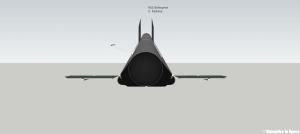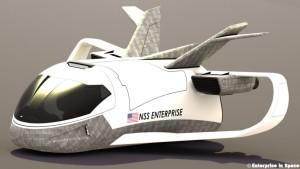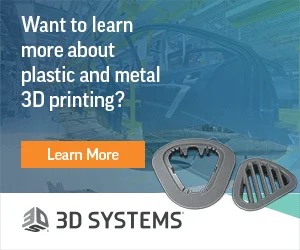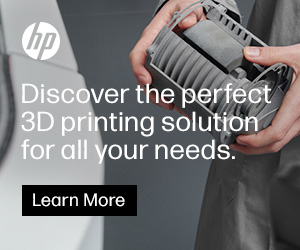Enterprise Spaceship Gets Real with 3D Printing in Educational Program by Smithsonian and NSS
 If a 3D printer can be considered an early (very early) version of Star Trek’s replicator, then there is no better place for it than the Enterprise. The National Space Society (NSS) and the Smithsonian Science Education Center (SSEC) are thus collaborating on the Enterprise In Space (EIS) project, and educational program that aims to use 3D printing to design, build, fly, and eventually return to Earth an orbiter containing student experiments.
If a 3D printer can be considered an early (very early) version of Star Trek’s replicator, then there is no better place for it than the Enterprise. The National Space Society (NSS) and the Smithsonian Science Education Center (SSEC) are thus collaborating on the Enterprise In Space (EIS) project, and educational program that aims to use 3D printing to design, build, fly, and eventually return to Earth an orbiter containing student experiments.
This EIS project is intended as a tribute to the many great visionaries of science and science fiction. As such it will demonstrate and pioneer new technologies while inspiring and encouraging space enterprise. In doing this it will promote the development of educational curricula and activities contributing to related future endeavors in science, technology, engineering, arts, and mathematics (STEAM).
A 3D Printed Enterprise is Going into Space
“The decision to collaborate with the Smithsonian Science Education Center was a natural one,” says Lynne Zielinski, EIS Education Program Manager and NSS Vice President of Public Affairs. “The Smithsonian has a prestigious reputation for its educational initiatives and will provide the ideal network and support necessary for bringing the EIS program to the public.”
As a part of its mission to send a 3D printed spacecraft into low Earth orbit with more than 100 student experiments aboard, EIS has established a robust online educational platform, the EIS Academy, which includes several Enterprise Centers for Excellence, dedicated to hosting knowledge from experts in space science. The SSEC is dedicated to the establishment of effective science programs and professional learning experiences for all teachers and students. Together, the SSEC and EIS will support one another in developing educator and student experiences in the STEAM area disciplines that enhance awareness in the exploration and development of space, and extend the reach of SSEC and EIS programs.
Educating Future Space Engineers
EIS and SSEC plan to collaborate on two projects dedicated to space education. The first is a mission patch design challenge in collaboration with the US Department of Education to present during a “Space Day” at the National Air and Space Museum. The second is the development of a space science summer course for the Smithsonian Science Education Academies for Teachers (SSEATs) that will enrich and enhance space education in the participating educators’ classrooms. EIS and SSEC will be creating a space science curriculum for leaders and learners that will be taught as a week-long SSEAT course. The course will use resources from the Smithsonian and its affiliates in the Washington, D.C. area, including access to museums, scientists, historians, and researchers at those facilities.
Class lessons created by participating teachers will be shared further by being uploaded to the EIS Academy. The program will also include an online course preceding the summer Space Science Academy and post-academy activities for follow-up networking and teacher collaborations.
“Space science topics are a timely and exciting subject area that motivates student learning,” said Carol O’Donnell, SSEC Director. “The EIS Academy offers a pathway for our SSEATs teachers to build long-lasting professional learning communities that will provide them with confidence and reinvigorate their enthusiasm while embracing cutting edge applications and best teaching practices.”
Although the EIS project is relatively small at this point its goals are significant and could yield immediate benefits both in terms of education and even for finding new solutions and applications for low-cost space exploration which – thanks to visionaries such as Elon Mask and the new possibilities opened by low-cost 3D printing, is shaping up to be a rapidly going sector over the next decades. It all begins with one small step.
Subscribe to Our Email Newsletter
Stay up-to-date on all the latest news from the 3D printing industry and receive information and offers from third party vendors.
You May Also Like
Poll of the Week: Best Dental 3D Printing Applications
We asked our LinkedIn followers, in our very first Poll of the Week, what kinds of stories they wanted to read more of on 3DPrint.com, and the final answer was...
Revo Foods to Rev up Mass Production of 3D Printed Alt-Salmon
One of the major challenges facing 3D printed food is its scalability in comparison to traditional food production. The 3D printing industry generally specializes in creating small items. It can...
Carbon Adds Three New 3D Printing Resins to Dental Materials Portfolio
Product development and manufacturing technology company Carbon has a very strong materials platform, including engineering-quality elastomers and photopolymers, for applications ranging from sportswear to medical and dental. This week, the...
Custom 3D Printed Eyewear, Now in Translucent Colors from Materialise
Way back in 2017, Fried Vancraen, CEO of Materialise, said he could foresee “a growing amount of meaningful applications” for 3D printing, which included customized eyewear. The Belgium-based 3D printing...









































